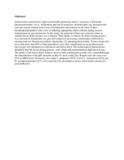| dc.contributor.author | Yao, A A | |
| dc.contributor.author | Dortu, C | |
| dc.contributor.author | Egounlety, M | |
| dc.contributor.author | Pinto, C | |
| dc.contributor.author | Edward, V A | |
| dc.contributor.author | Huch, M | |
| dc.contributor.author | Franz, C M A P | |
| dc.contributor.author | Holzapfel, W | |
| dc.contributor.author | Mbugua, S | |
| dc.contributor.author | Mengu, M | |
| dc.contributor.author | Thonart, P | |
| dc.date.accessioned | 2013-04-25T12:37:07Z | |
| dc.date.available | 2013-04-25T12:37:07Z | |
| dc.date.issued | 2009-10 | |
| dc.identifier.citation | African Journal of Biotechnology Vol. 8 (19), pp. 4996-5004, 5 October, 2009 | en |
| dc.identifier.issn | 1684-5315 | |
| dc.identifier.uri | http://www.academicjournals.org/AJB | |
| dc.identifier.uri | http://erepository.uonbi.ac.ke:8080/xmlui/handle/123456789/16818 | |
| dc.description | Journal article | en |
| dc.description.abstract | Sixteen lactic acid bacteria, eight Lactobacillus plantarum, three L. pentosus, 2 Weissella
paramesenteroides, two L. fermemtum and one Leuconostoc mesenteroides ssp. mesenteroides were
previously isolated from cassava fermentation and selected on the basis of their biochemical properties
with a view to selecting appropriate starter cultures during cassava fermentation for gari production. In
this study, the potential of these pre-selected strains as suitable freeze-dried cultures was evaluated.
Their ability to tolerate the freeze-drying process was assessed by dehydration in a glycerol solution of
increasing concentration, followed by staining with two fluorescent markers: rhodamine 123 and
propydium iodide. Twelve strains that recovered more than 50% of their population value after
visualisation on an epi-fluorescent microscope were produced in a bioreactor and freeze-dried. The
technological characteristics identified after the freeze-drying process, were a high cell concentration
or high survival rate. The ability of the freeze-dried strains to recover their acidification activity was
evaluated through the determination of the pH, titratable acidity (% lactic acid/g Dry Weight) and cell
count over 24 h on MRS broth. Ultimately, the strains L. plantarum VE36, G2/25, L. fermentum G2/10 and
W. paramesenteroides LC11 were selected to be developed as freeze-dried starter cultures for gari
production. | en |
| dc.language.iso | en | en |
| dc.subject | Freeze-drying | en |
| dc.subject | Gari | en |
| dc.subject | Lactic acid bacteria | en |
| dc.subject | Fermentation | en |
| dc.subject | Starter culture | en |
| dc.subject | Cassava | en |
| dc.subject | Developing countries | en |
| dc.subject | Fermented food | en |
| dc.title | Production of freeze-dried lactic acid bacteria starter culture for cassava fermentation into gari | en |
| dc.type | Article | en |
| local.publisher | Department of Food Science, Nutrition and Technology, University of Nairobi | en |

